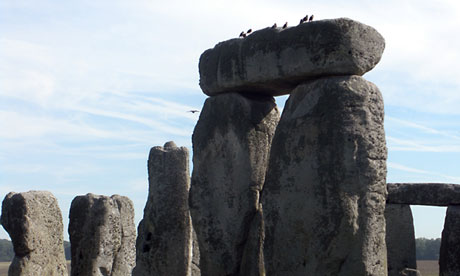Stonehenge was built on solstice axis, dig confirms
English Heritage excavations show site has nothing to do with sun worshipping, and find evidence circle was once complete

Archeologists found ridges, formed by Ice Age meltwater, that align Stonehenge with the solstice axis. Photograph: Francis Dean/Rex
English Heritage says it has discovered a "missing piece in the jigsaw" in our understanding of Stonehenge, England's greatest prehistoric site. Excavations along the ancient processional route to the monument have confirmed the theory that it was built along an ice age landform that happened to be on the solstice axis, according to Professor Mike Parker Pearson, a leading expert on Stonehenge.
The Avenue was an earthwork route that extended 1.5 miles from the north-eastern entrance to Wiltshire's standing stones to the River Avon at West Amesbury. Following the closure of the A344 road, which cut across the route, archaeologists have been able to excavate there for the first time.
Just below the tarmac, they have found naturally occurring fissures that once lay between ridges against which prehistoric builders dug ditches to create the Avenue. The ridges were created by Ice Age meltwater that happen to point directly at the mid-winter sunset in one direction and the mid-summer sunrise in the other.
Parker Pearson said: "It's hugely significant because it tells us a lot about why Stonehenge was located where it is and why they [prehistoric people] were so interested in the solstices. It's not to do with worshipping the sun, some kind of calendar or astronomical observatory; it's about how this place was special to prehistoric people.
"This natural landform happens to be on the solstice axis, which brings heaven and earth into one. So the reason that Stonehenge is all about the solstices, we think, is because they actually saw this in the land."
The findings back theories that emerged in 2008 following exploration of a narrow trench across the Avenue. Parker Pearson said: "This is the confirmation. It's being able to see the big picture."
Dr Heather Sebire, English Heritage's Stonehenge curator, said: "The part of the Avenue that was cut through by the road has obviously been destroyed forever, but we were hopeful that archaeology below the road would survive. And here we have it: the missing piece in the jigsaw. It is very exciting to find a piece of physical evidence that officially makes the connection which we were hoping for."
The excavation was conducted by Wessex Archaeology for English Heritage.
The A344 will be grassed over next year as part of English Heritage's £27m transformation of the World Heritage Site, which receives more than 1m visitors annually. There will be a new visitor centre, 1.5 miles away out of sight, to allow Stonehenge to reconnect with the surrounding landscape.
Sebire, who likens the Avenue to The Mall leading to Buckingham Palace, said that the latest findings should prompt vigorous academic debate. English Heritage has not expressed an opinion on the naturally formed ridges, its interpretation being confined to the ditches.
Archaeologists have also identified three holes where missing stones would have stood on the outer sarsen circle - evidence, it is believed, that the circle was indeed once complete. Surprisingly, even the most sophisticated surveys failed to spot them. Two members of staff noticed dry areas of grass, or parchmarks.
Susan Greaney, an English Heritage historian, said: "The discovery … has certainly strengthened the case for it being a full circle."
Asked why no one noticed them until now, Parker Pearson said: "The problem is we've not had a decent dry summer in many years. Stonehenge is always regularly watered, and the only reason these have shown up is because – for some reason this year – their hose was too short … So we're very lucky."
• This article was amended on 9 September 2013 to clarify that English Heritage has not expressed an interpretation of the naturally formed ridges, but only of the ditches.
No comments:
Post a Comment